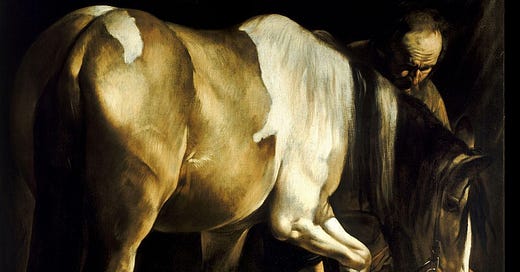One of the most vivid images in the collective imagination of Christianity is the conversion of St. Paul, celebrated by the Church on January 25. Rightly so. This dramatic image of a man transforming from a persecutor of Christians into a Christian himself is deeply thought-provoking. We naturally recall Caravaggio’s beautiful painting, depicting St. Paul fallen from his horse, illuminated by a supernatural light. Notably, the horse raises a hoof, as if ready to strike the man lying on the ground—Paul. This hoof, too, is illuminated.
I find it significant that the scene is lit by a supernatural light, highlighting both a man on the ground and a potential threat. I don’t believe this is an overinterpretation of Caravaggio’s work, as he was a man who lived a dramatically tumultuous life. It’s no coincidence that he sought to transfigure the darker aspects of his existence, much like St. Paul, into a supernatural light.
Piero Bargellini, writing on santiebeati.it, observes about this liturgical feast:
“Since the martyrdom of the Apostle to the Gentiles is commemorated in June, today’s celebration offers the opportunity to closely consider the multifaceted figure of the Apostle par excellence, who wrote of himself: ‘I have worked harder than all the other apostles,’ but also: ‘I am the least of the apostles, an untimely birth, unworthy to be called an apostle.’ Paul himself provides the credentials that justify his status as an apostle: he has seen the Lord, the Risen Christ, and is therefore a witness to the resurrection; he was also directly sent by Christ, like the Twelve. Vision, vocation, mission—three qualifications he possesses, all stemming from that miracle of grace on the road to Damascus, where Christ compelled him to surrender unconditionally, prompting him to cry out: ‘Lord, what do you want me to do?’In Christ’s words, the secret of Paul’s soul is revealed: ‘It is hard for you to kick against the goad.’ It is true that Saul sought ‘in all the synagogues to compel Christians with threats to blaspheme,’ but he did so in good faith, and when one acts out of love for God, any misunderstanding cannot last long. Restlessness arises—this is the ‘goad’ of grace, the spark of the light of truth: ‘Who are you, Lord?’; ‘I am Jesus, whom you are persecuting.’ This mystical irruption of Christ into Paul’s life is the seal of his apostleship and the spark that unveils the wondrous truth of Christ’s inseparable unity with believers.”
It is worth noting that Jesus often chooses the most vulnerable, those who have committed great sins, to bring closer to Him. Fulton Sheen once said: “The capacity for conversion is greater in truly wicked individuals than in those who are self-satisfied and complacent.” And here, Jesus does not merely make Paul a Christian but transforms him into the Apostle to the Gentiles.
In the liturgy of the feast of the conversion, we read this passage from the Acts of the Apostles, chapter 9:
“Saul, still feeling threats and murder against the disciples of the Lord, went to the high priest and asked him for letters to the synagogues at Damascus, so that if he found any belonging to the Way, men or women, he might bring them bound to Jerusalem. As he journeyed, he approached Damascus, and suddenly a light from heaven shone around him. And falling to the ground, he heard a voice saying to him, ‘Saul, Saul, why are you persecuting me?’ And he said, ‘Who are you, Lord?’ And he said, ‘I am Jesus, whom you are persecuting. But rise and enter the city, and you will be told what you are to do.’ The men who were traveling with him stood speechless, hearing the voice but seeing no one. Saul rose from the ground, and although his eyes were opened, he saw nothing. So they led him by the hand and brought him into Damascus. For three days he was without sight, and neither ate nor drank.”
Jesus not only converts him but also identifies him—as His persecutor.
Keep reading with a 7-day free trial
Subscribe to Cantus to keep reading this post and get 7 days of free access to the full post archives.



